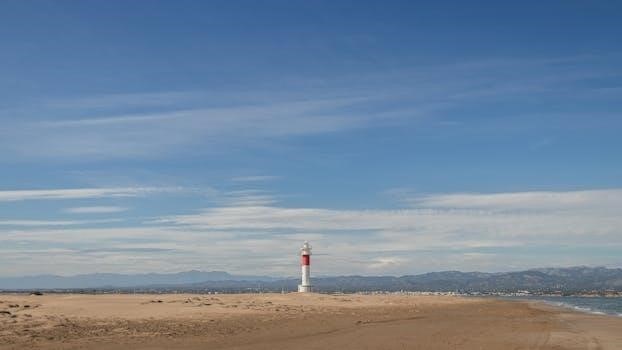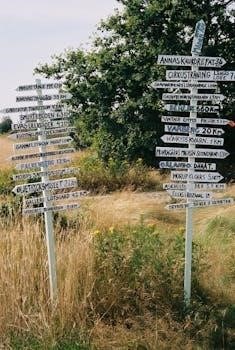
Overview of Sam Thayer’s Field Guide
Sam Thayer’s field guide is a comprehensive resource for identifying edible wild plants․ This 736-page softcover book is designed for both beginner and experienced foragers․ It covers over 600 species with detailed descriptions․

Samuel Thayer‚ a leading authority on edible wild plants in North America‚ began his foraging journey in childhood in Wausau‚ Wisconsin․ He has personally consumed every species included in his field guide‚ establishing his credibility․ Thayer’s previous compendiums were widely used by foragers‚ but were considered bulky․ His latest field guide addresses this issue‚ providing a more portable option․ He is the author of multiple books about edible plants‚ including “Foragers Harvest‚” and “Incredible Wild Edibles‚” and this field guide is his most recent work․ It stands out as the most comprehensive guide ever written to the edible wild plants of the region․ Thayer’s work has been recognized by the National Outdoor Book Award‚ solidifying his status as a leading expert in the field of wild edibles․ His deep knowledge and practical experience are evident throughout his writings․
Key Features of the Field Guide
This field guide distinguishes itself through several key features․ It uses a novel identification system based on everyday language‚ making it accessible to both beginners and advanced foragers․ The guide includes 1‚700 clear color photos and 625 range maps‚ aiding in accurate identification․ It covers 679 edible species‚ substantially more than other guides like the Peterson Guide․ This comprehensive coverage ensures that users have a wide range of plants to explore․ The guide also includes detailed information on each plant’s habitat‚ conservation status‚ edible parts‚ and seasons of harvest․ Furthermore‚ it details methods of preparation‚ enhancing the practical value of the book․ Designed to stand alone‚ the guide also works with phone-based identification apps‚ offering a dual approach for confirming a plant’s identity․ The layout and content emphasize ease of use․

Identification System
The guide employs a novel identification system that uses common‚ everyday language․ This approach makes plant identification accessible to both novice and experienced foragers․ It is also designed to complement phone-based identification apps․
Novel Identification System Using Everyday Language
Sam Thayer’s field guide distinguishes itself by pioneering a unique identification system․ This system moves away from complex botanical jargon‚ instead utilizing common‚ everyday language that is easily understood by a wide range of users‚ from beginners to seasoned foragers․ The goal is to make plant identification less daunting and more approachable for everyone․ This novel approach emphasizes clear and descriptive terms‚ focusing on readily observable characteristics that anyone can recognize without specialized knowledge․ By avoiding technical language‚ Thayer’s guide enables users to quickly and confidently identify plants in the field‚ making the foraging experience both educational and enjoyable․ This simplification of the identification process promotes self-reliance and empowers individuals to engage with nature more directly and safely․ The use of plain language makes the guide a valuable resource for families and groups of mixed experience levels․
Use with Phone-Based Identification Apps
Recognizing the increasing popularity and accessibility of technology‚ Sam Thayer’s field guide is designed to complement phone-based identification applications․ The guide’s identification system‚ while effective on its own‚ can be used in conjunction with digital apps to enhance the accuracy and confidence in plant identification․ Foragers can use the guide to narrow down potential species and then use a phone app to confirm their findings through image recognition or other features․ This combined approach is particularly useful when encountering difficult or ambiguous plants․ The synergy between the traditional field guide and modern technology provides a reliable method for verifying identifications before consumption․ This is particularly beneficial for those who are still learning about wild edibles․ The field guide thus becomes a tool for learning‚ while the phone apps serve as a secondary check for safety․ This dual method is practical and ensures that foragers are well-equipped to handle various situations in the field․

Content and Scope
This comprehensive guide covers a wide array of edible plants found in eastern and central North America․ It includes detailed information on numerous species‚ with clear photos and range maps․
Number of Plant Species Covered
Sam Thayer’s field guide stands out for its extensive coverage of edible wild plants․ This guide meticulously details over 600 different species‚ providing foragers with a broad spectrum of plants to identify and learn about․ This quantity significantly surpasses that of many other field guides‚ making it a particularly valuable resource for those looking to expand their knowledge of wild edibles․ The inclusion of so many species ensures that users can find information on a wide variety of plants they may encounter in their foraging expeditions․ Furthermore‚ this extensive list is complemented by clear and concise descriptions‚ detailed identification keys‚ and high-quality color photos‚ enabling accurate identification even for those new to foraging․ It is stated that this guide offers 320 more species than the Peterson guide․ This wide selection makes it the most complete guide of its kind․
Geographic Coverage⁚ Eastern and Central North America
Sam Thayer’s field guide specifically focuses on the edible wild plants found in Eastern and Central North America․ This targeted geographic scope makes the guide highly relevant for foragers in this region․ By concentrating on this area‚ the book provides in-depth information on plant species that are commonly encountered within these boundaries․ This focused approach ensures that the identification keys‚ descriptions‚ and range maps are accurate and applicable to the specific flora found in this part of the continent․ The guide’s geographic specificity is a significant advantage for individuals who forage in this area‚ providing them with a reliable resource tailored to their environment․ This detailed coverage makes it an indispensable tool for those seeking to safely and accurately identify edible plants․ In contrast to guides with a broader scope‚ this guide offers a deeper‚ more thorough approach․

Additional Information
Beyond identification‚ Thayer’s guide includes details on plant habitats and conservation․ It also explains which parts of the plants are edible‚ the seasons for harvest‚ and methods of preparation․
Habitat and Conservation
Sam Thayer’s field guide goes beyond simple plant identification‚ delving into the crucial aspects of habitat and conservation․ Understanding where a plant thrives is essential for successful foraging and ensuring the sustainability of wild populations․ The guide meticulously describes the typical environments where each edible species can be found․ This includes details about the soil type‚ moisture levels‚ sunlight exposure‚ and associated plant communities․ This knowledge allows foragers to more accurately predict where to look for specific species‚ increasing their chances of finding them․ Furthermore‚ the guide emphasizes the importance of responsible harvesting practices․ It provides guidelines on how to forage in a way that minimizes impact on plant populations and their habitats․ This includes avoiding over-collection‚ respecting sensitive areas‚ and being mindful of the overall health of the ecosystem․ The guide also promotes an understanding of the role that specific plants play within their respective environments‚ encouraging foragers to become stewards of the natural world․ By integrating habitat information and conservation tips‚ Thayer’s guide fosters a deeper appreciation for the interconnectedness of plants and their surrounding ecosystems‚ promoting sustainable foraging practices․
Edible Parts and Seasons
A crucial component of Sam Thayer’s field guide is its detailed coverage of edible plant parts and their respective seasons․ For each of the 600+ species detailed‚ the guide specifies which parts of the plant are safe for consumption‚ ranging from roots and stems to leaves‚ flowers‚ and fruits․ This information is presented clearly‚ leaving no room for ambiguity‚ which is very important for safety․ The guide also meticulously outlines the specific time of year when each edible part is at its peak flavor and nutritional value․ This seasonal approach ensures that foragers harvest plants at their prime‚ maximizing taste and nutritional benefit․ The guide recognizes that seasons vary slightly depending on the geographic location․ It provides an understanding of these variations‚ allowing for more precise harvesting․ This focus on timing is not just for optimal flavor but also to safeguard plant populations‚ ensuring that foraging does not interfere with their natural reproductive cycles․ By offering detailed information on edible parts and their seasons‚ the guide enables foragers to make informed and responsible decisions when gathering wild plants‚ enhancing both the foraging experience and the preservation of natural resources․
Preparation Methods
Beyond identification and seasonal information‚ Thayer’s field guide also offers valuable insights into preparation methods for the wild edibles․ Recognizing that many wild plants require specific cooking or processing techniques to make them palatable and safe‚ the guide dedicates considerable attention to this crucial aspect of foraging․ For each edible species‚ it provides detailed guidance on how best to prepare the harvested parts․ This may include boiling‚ sautéing‚ steaming‚ roasting‚ or even eating raw‚ depending on the plant and its properties․ The guide also addresses any potential need for detoxification or removal of specific compounds that may be present in some plants․ These instructions are presented clearly and concisely‚ ensuring that readers understand how to transform their foraged finds into enjoyable meals․ This includes information on how to store foraged items to maintain freshness and quality‚ along with some basic recipes․ This comprehensive approach to preparation allows users to fully utilize the edible plants they identify‚ making the guide an indispensable resource for anyone interested in wild food․